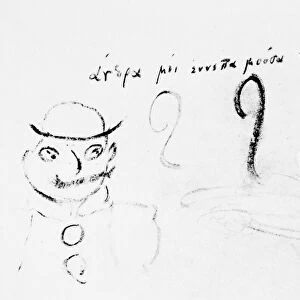Homo sapiens skull (Predmosti 3) C016 / 4969
![]()

Wall Art and Photo Gifts from Science Photo Library
Homo sapiens skull (Predmosti 3) C016 / 4969
Homo sapiens skull (Predmosti 3). Cast and reconstruction of the fossil cranium and mandible of a modern human (Homo sapiens) male. This individual is aged 35 to 40 years. The fossil remains were discovered in June 1894 by K. J. Maska, at Predmosti, north-east Moravia, in what is now the Czech Republic. It dates from around 30, 000 years ago
Science Photo Library features Science and Medical images including photos and illustrations
Media ID 9205657
© NATURAL HISTORY MUSEUM, LONDON/SCIENCE PHOTO LIBRARY
Ancestral Anthropological Anthropology Bones Cast Cranium Czech Republic Evolutionary Fossil Fossil Man Fossilisation Fossilised Fossilization Fossilized Fossils Hominid Hominin Homo Sapiens Human Ancestors Human Evolution Human Fossils London Natural History Natural History Museum Oblique Palaeoanthropological Palaeoanthropology Palaeolithic Palaeontological Paleoanthropological Paleoanthropology Paleolithic Paleontological Pleistocene Prehistoric Prehistory Specimen Stone Age Cutouts Moravia Palaeontology Predmosti Three Quarter View
EDITORS COMMENTS
This print showcases the Homo sapiens skull (Predmosti 3) C016 / 4969, offering a glimpse into the ancient past of our human ancestors. The cast and reconstruction of this fossil cranium and mandible belong to a modern human male estimated to be between 35 and 40 years old. Discovered in June 1894 by K. J. Maska at Predmosti, north-east Moravia (now Czech Republic), these remains date back approximately 30,000 years. Against a striking black background, this historical artifact takes center stage, highlighting its significance in natural history and anthropology. The studio shot captures every intricate detail of the skull's oblique angle, emphasizing its evolutionary importance. As an ancestral specimen from the Stone Age, this fossilized cranium offers valuable insights into human evolution during the Pleistocene era. Its presence in the Natural History Museum in London serves as a testament to our curiosity about our own origins. The image invites viewers to contemplate their place within the vast timeline of existence while marveling at how far humanity has come since those prehistoric times. It is a reminder that we are all connected through our shared biological heritage and encourages us to explore further into paleontology and paleoanthropology for answers about our collective past.
MADE IN THE USA
Safe Shipping with 30 Day Money Back Guarantee
FREE PERSONALISATION*
We are proud to offer a range of customisation features including Personalised Captions, Color Filters and Picture Zoom Tools
SECURE PAYMENTS
We happily accept a wide range of payment options so you can pay for the things you need in the way that is most convenient for you
* Options may vary by product and licensing agreement. Zoomed Pictures can be adjusted in the Cart.











